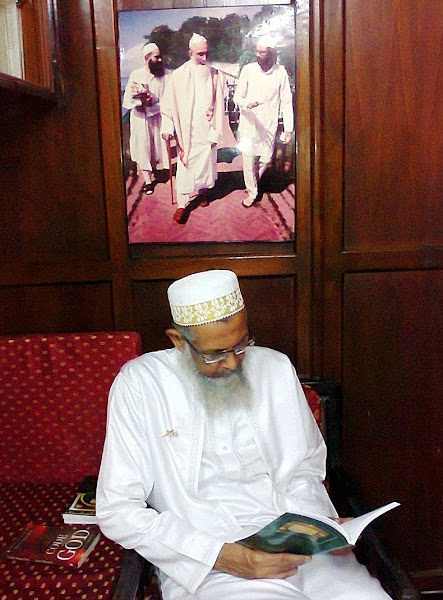I was always eager to know how and in which period of history the Fatemi Dawat took its root in India, and who were the first harbingers, their background and their Mission. By referring to different sources, I am presenting the episodes of Fatemi Dawat in Hind, the historical events as oit unfolded in the early Eleventh Century.
In Misr during the glorious reign of Imam Mustansir Billah ( S.A.) a Hindu Raja Siddhrath Jaisingh was the ruling from Khambat. After the advent of Islam many Arabs had been steadily coming down to Hindustan and Islam was slowly spreading with marked concentration in areas around Delhi and Lucknow.
Islam was spreading far and wide and this made the head priest of Raja Jaisingh very apprehensive, and in order to save the kingdom from an alien religion, he advised the Raja to take a vow not to partake food before killing a Muslim each day and making a tilak with the blood of the killed Muslim.
One day an Arab trader owing allegiance to the Fatemi Dawat happened to travel to Khambat and was caught by the guards and brought before the Raja, who ordered him to be executed. However, by his convincing arguments, the trader managed to convey to the Raja that he need not kill him to keep his vow, he may chop off his hand, and with the blood to tilak and partake his food.
Thus he saved himself and managed to travel back gto Misr and appeared in the Hazrat of Imam (S.A.) and narrated the incident Imam Mustansir Billah (S.A.) planted the seed of Fatemi Dawat by sending Moulayee Ahmad to Khambat to ascertain the prevailing religion and culture and to seek converts.
In the guise of a Hindu sage Moulayee Ahmad stayed in Khambat and obsereved the customs and traditions. During his wanderings Moulayee Ahmad took a liking of two young lads aged between 12-14 years, who appeared to be very bright and intelligent. He found out that both these boys were orphans, who lived with their relatives. One was Ramnath and the other was Roopnath. Moylayee Ahmad won their trust and confidence, so much so that they started living with him and also agreed to accompany him to Misr.
On reaching Misr the two boys were presented in Hazarat Aliyah Immamiyah and were entrusted in the care of Moulayee Lamak, who lovingly instructed the two boys in Fatemi Ulooms. Thus Ramnath became Moulayee Abdullah and Roopnath became Moulayee Nuruddin. Imam (S.A.) instructed Sayedna Lamak to accompany them till Yemen and from there, the three Sahebs set sail and landed in Khambat harbour in the year 453 H and started the Fatemi Dawat in earnest.
Moulayee Ahmad was the first Vali e Hind and started his mission from Khambat. He sent Moulayee Nuruddin to the Deccan Central India and Moulayee Abdullah to Patan. Around Khambat Moulayee Ahmad won over many hearts by his knowledge, saintly character and miracles, and the news of his mission travelled far and wide, and in due course of time the two prominent vazirs of Raja Jaisingh, namely Raja Bharmal ( who was also son in law of Raja Jaisingh ) and Raja Tarmal came under the influence of Islam.
The famous incident of the hung Elephant in the Temple that attracted a lot of devotees, in which case Moulayee Ahmad removed the concealed magnates from the floor and roof of the Temple, which made the rock Elephant come crushing down, shook the Hindu belief as never before, and many converts were won over. It is said that before his death even Raja Jaisingh gave Misaq to Moulayee Ahmad. On his death bed he gave instruction that he should not be consigned to flames as per Hindu custom, but was to be buried and the his last rites were to be conducted by Moulayee Ahmad. Year 1143 A.D.
When the first Vali e Hind Moulayee Ahamad died in Khambat in 560 H Moulayee Nuruddin became the Second Vali e Hind and on his death in Dongaon in the year 563 H Moulayee Abdullah became the 3rd Vali e Hind. Moulayee Abdullah died in Patan in 565 H.
The 4th Vali e Hind was Moylayee Yakub who was the son of Raja Bharmal, and before openly giving allegiance at the hands of Moyalee Ahmad was known as Ajaypal. He helped a great deal in winning over converts to the Fatemi Dawat.
Moylayee Yakub the 4th Vali e Hind directed Sayedi Fakhruddin Saheed ( son of Raja Tarmal) to spread Deen and win over converts in vaghad bilad (Gujrat - Rajastan bordering areas) It was near Galiyakot that he was looted and martyred by the Bhills.
In the descendents of Moylaee Yakub came the Nine Doat Mutlaqeen known as A'al e Bharmal. The first amongst them being 34th Dai ul Mutlaq Sayedna Ismail Badruddin Moula - Jamnagar.
1065 to 1085 H.
Aqa A'li Qdr Muffadal Moula's lineage is traced back to both Raja Bharmal and Raja Tarmal.
